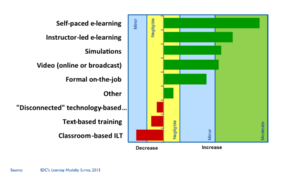Editor’s Note: In an attempt to broaden our interaction with our readers we have created this Reader Forum for those with something meaningful to say to the wireless industry. We want to keep this as open as possible, but we maintain some editorial control to keep it free of commercials or attacks. Please send along submissions for this section to our editors at: dmeyer@rcrwireless.com.
Companies and their workforces are going mobile. It’s not just an idea anymore, it’s happening right now.
Mobile devices, applications and workers — ROI is all about adoption
As companies continue to ramp up their mobility efforts, there are still some major questions on how they can implement successful programs and measure returns.
“[Forty percent] of current salespeople are making use of a mobile solution involving tablets,” according to Joe Hewitson in his article “Tablets give rise to a smarter, more effective sales team.” “Among the executives in those tablet-wielding salespeople, 70% are seeing a tangible return on investment. With 90% of surveyed sales organizations reporting plans for increased investment in tablet sales solutions, we can clearly see that the benefits of tablet driven sales tools are turning some important heads.”
So, as more and more companies invest in mobile solutions, it is important to understand how companies can attain and measure a return on investment for those efforts.
Laying a foundation
In order to evaluate and build your mobile solution to reach maximum effectiveness, you need a foundation that allows you to measure your strategy, a baseline. So the top priority is, and always will be, getting devices into the hands of a workforce.
“The drive for pervasive access to information on the part of consumers and enterprise employees continues to accelerate, with the near ubiquitous availability of adequate bandwidth and rapid increase of smartphone and tablet adoption making mobile one of the top priorities on a CIO’s priority list,” according to Gartner in its July 2014 report, “The future of Enterprise Applications is Mobility.” “The digital enterprise is increasingly a mobile enterprise.”
Still, mobile business solutions must be effective, customized, well taught and well maintained in order for workers to continue to utilize them as desired.
Mobile adoption: the basics
Companies are pouring management efforts into addressing the cultural shift to out-of-the-office work environments and business processes. As a result, one of the central purposes of mobile business applications is to give a workforce the freedom to work out of the office, and still access the information and tools they need to be effective.
In order to accomplish that, it’s not enough to just equip them with mobile devices and expect true value outcomes or ROIs to begin occurring naturally. The mobile device, be it a smartphone or tablet, is simply the vehicle to the mobile solutions that will make your workforce more engaged and effective. The mobile applications are what will stimulate ROI, as they are the interface to access the information necessary to do the job well.
Creating your mobile solution
In order for your mobile business programs to be effective they need to be designed with your workforce in mind. Currently, there are four generations in the workforce which encompasses many diverse learning styles to support, but surprisingly they all have one thing in common, impatience.
Workers need their learning tools and performance support to fit a culture of “justs”:
• Just in time: Workers want business tools to be available on-demand when they need them.
• Just enough: Workers want the information and support necessary in digestible, succinct pieces.
• Just for me: Workers want customized, personalized learning at their own pace.
In order to satisfy these wishes, the content should integrate on-demand learning and real-time performance support, consisting of:
• Interactive simulations
o Example: A recording of a process of an expert using business application or technologies step by step allowing the user to interact safely.
• Video
o Example: The CEO explaining the change to the business or an expert operating a new mobile phone.
• Step-by-step instructions
o Example: Flat or layered online documentation to guide a worker through a process.
• Multimedia e-learning
o Example: Conceptual, multimedia online courses about a change to the operations of the sales organization including processes, tools, systems, policies, etc. Components include everything above.
To really drive it home, all of these solutions must be available at all times, for instructor-facilitated sessions as well as self-facilitated performance support at the time of need.
According to IDC, personalization of learning and performance support is on the minds of those investing in learning modalities. In the IDC research conducted by Cushing Anderson, the 2013 Learning Modality Survey showed that participants are drastically changing their habits toward e-learning, both self-paced and instructor-led:
Companies have significant opportunity for personalization when creating e-learning programs. Turning to e-learning solutions isn’t just about the workforce’s ability to move at their own pace, it’s also about engaging with content that was tailored to their needs. Mobile learning and adaptation is no different, and just adds another opportunity to personalize content based on who the learner is, and where they are.
• Language – to ensure all instruction and support are in the language of the worker.
• Format – to match learning style and interface including smartphones and tablets.
• Length – to match the tolerance, patience, and availability of the worker.
• Interactivity – to engage the worker in new operations and practices.
Next steps
Even when you have the ideal mobile solution in place, implementation can become complicated. As Gartner notes in its report The Future of Enterprise Applications is Mobility, “with the shift in business and consumer applications to mobile devices, many issues will arise around issues such as ROI, security, scalability, availability and integration.”
Businesses will have to keep these sensitive elements in mind when implementing mobile solutions into their workforces, and they can take a few basic steps to ensure a successful mobile strategy:
1. Find the subject matter experts:
In order to increase the odds of success, find the experts in the business, the technology and the functionality. These individuals will lead the effort in adopting mobile solutions within your company and will remain the key point of contact for mobile strategy. Enable them to develop assets for learning and performance support as well as methods for measuring the success of mobile learning systems. By finding such individuals to invest their time in mobile adoption, they will support the worker, drive customer satisfaction (internal or external), and ensure and recognize success through ROI.
2. Adapt all programs to multiple interfaces
In order to make sure the learning systems are effective, they must be available to workers in several environments. Therefore, businesses must make sure the systems and applications can run on a number of interfaces, including computers, smart phones and tablets of varying operating systems. Adapting the programs to all devices will also allow businesses to integrate them into business models with greater ease.
3. Train employees on mobile applications
Even millennial workers who are experts at manipulating mobile devices need to understand proper usage of the business applications made available to them. Thoroughly training workers on the applications is paramount, as there is no room to fumble or guess in front of customers and senior management, especially the CIO. Workers’ mastery of the mobile business applications is a reflection of one’s business practices, and also ensures proper usage to avoid security issues that may otherwise arise.
The “trick” is to manage the investment in development and maintenance of this learning and performance support. Develop one set of assets to support the worker and use them all whenever and wherever needed. That obliges the developer to ensure all published content is able to be deployed to any mobile device, desktop, laptop, or classroom (traditional or virtual).
The adaptation of a mobile strategy is dependent on workforce adoption, not just the day workers receive their devices but every day, as the technology and innovations evolve.


